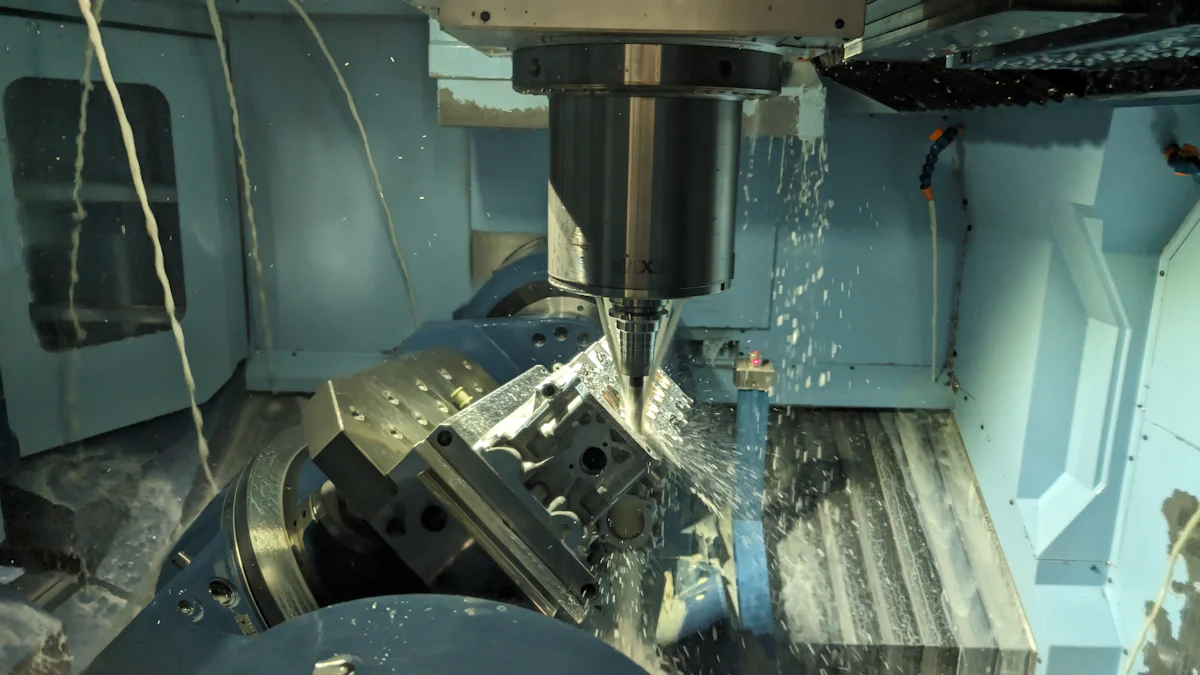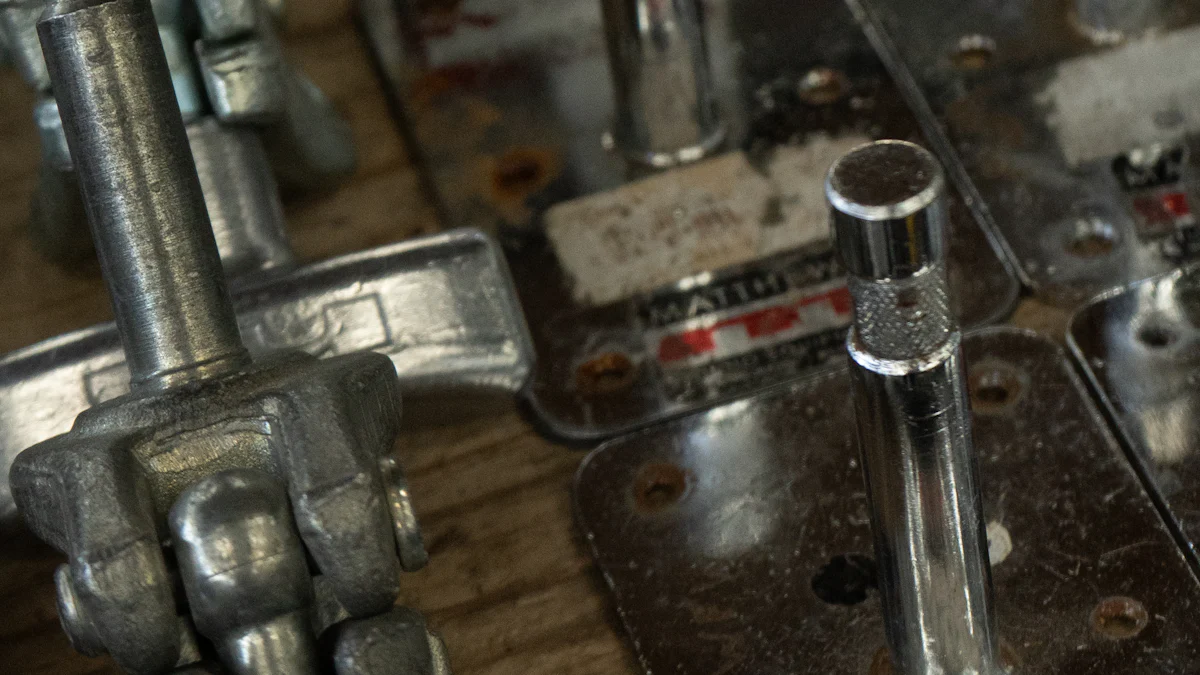What Is the Role of QFD, FMEA, and DOE in Manufacturing Quality?

Manufacturing depends on robust tools to guarantee product excellence. QFD, FMEA, and DOE are prominent qualitymethod approaches in this field. QFD converts customer needs into actionable design specifications, ensuring products meet expectations. FMEA detects and mitigates potential risks, improving reliability and minimizing defects. DOE enhances processes by analyzing variables to maintain consistent quality. Collectively, these qualitymethod techniques serve as a foundation for an effective quality management system, promoting quality assurance and operational excellence.
Key Takeaways
QFD (Quality Function Deployment) ensures that customer needs are translated into actionable design specifications, enhancing product quality and customer satisfaction.
FMEA (Failure Mode and Effects Analysis) proactively identifies potential risks in manufacturing processes, allowing teams to implement preventive measures and reduce defects.
DOE (Design of Experiments) optimizes manufacturing processes by systematically testing variables, ensuring consistent quality control and reducing variability.
Integrating QFD, FMEA, and DOE creates a robust framework for quality management, promoting operational excellence and continuous improvement in manufacturing.
Fostering cross-functional collaboration among teams enhances the effectiveness of these quality methods, ensuring seamless integration of customer requirements into production workflows.
Embracing emerging technologies like AI and IoT can further enhance quality assurance efforts, enabling manufacturers to predict defects and optimize processes in real-time.
Adopting a culture of continuous improvement and providing comprehensive training are essential for successfully implementing these quality methods in manufacturing.
Overview of QFD, FMEA, and DOE as Quality Methods
QFD: Translating Customer Needs into Production Quality
Quality Function Deployment (QFD) serves as a structured approach to ensure that customer needs align with product design. This qualitymethod transforms customer expectations into actionable specifications during the design phase. By embedding quality considerations early in the process, QFD helps manufacturers improve production quality and meet customer demands effectively.
QFD emphasizes customer-centricity by translating their preferences into engineering requirements. For example, if customers prioritize durability, QFD ensures that materials and processes reflect this need. This method fosters collaboration among cross-functional teams, including design, engineering, and production, to achieve seamless integration of customer expectations into manufacturing workflows. Ultimately, QFD enhances product quality and strengthens customer satisfaction.
FMEA: Identifying and Mitigating Risks in Manufacturing
Failure Mode and Effects Analysis (FMEA) is a proactive tool used to identify potential risks in manufacturing processes. It systematically evaluates possible failure modes, their causes, and their effects on product quality. By addressing these risks early, FMEA minimizes defects and ensures quality assurance throughout the production cycle.
FMEA prioritizes risks based on their severity, occurrence, and detection likelihood. Manufacturers use this method to implement preventive measures, reducing the chances of failures impacting production quality. For instance, identifying a potential equipment malfunction allows teams to schedule maintenance before it disrupts operations. FMEA not only safeguards product quality but also promotes a culture of continuous improvement within manufacturing environments.
DOE: Optimizing Processes for Quality Control
Design of Experiments (DOE) focuses on optimizing manufacturing processes to maintain consistent quality control. This method involves systematically testing variables to determine their impact on production outcomes. By analyzing these interactions, DOE helps manufacturers refine processes and achieve optimal product quality.
DOE reduces variability in production by identifying the best combination of factors, such as temperature, pressure, or material composition. For example, adjusting these parameters can enhance efficiency while maintaining high-quality standards. This method supports quality assurance by ensuring that processes consistently deliver products that meet or exceed customer expectations. DOE plays a critical role in improving production quality and fostering operational excellence.
Applications of QFD, FMEA, and DOE in Manufacturing

QFD Applications in Quality Assurance
Aligning product design with customer expectations.
QFD plays a pivotal role in aligning product design with customer expectations. By translating customer needs into specific design requirements, manufacturers ensure that products meet or exceed expectations. For instance, a leading smartphone manufacturer utilized QFD to streamline its development process. This approach resulted in a significant gain in market share by delivering products that resonated with customer demands.
QFD also helps manufacturers focus on critical aspects of production quality, such as durability, functionality, and aesthetics. By embedding these elements into the design phase, manufacturers improve production quality while maintaining adherence to quality standards. This proactive approach ensures that customer satisfaction remains a top priority throughout the manufacturing process.
Enhancing cross-functional collaboration.
QFD fosters collaboration among cross-functional teams, including design, engineering, and production departments. This collaboration ensures seamless integration of customer requirements into the manufacturing workflow. Tesla, for example, aligns QFD with FMEA to enhance both innovation and reliability in its electric cars. This integration allows teams to work cohesively, addressing potential challenges early in the process.
By promoting teamwork, QFD minimizes communication gaps and enhances decision-making. Teams can collectively identify areas for improvement, ensuring that production quality remains consistent. This collaborative effort not only strengthens quality assurance but also supports continuous improvement in manufacturing practices.
FMEA Applications in Risk Management
Identifying potential failure modes in processes.
FMEA serves as a critical tool for identifying potential failure modes in manufacturing processes. It systematically evaluates risks, enabling manufacturers to address issues before they impact production quality. Automotive manufacturers frequently use FMEA to analyze the complex workings of vehicles. This method improves product quality and reliability by identifying root causes of potential failures.
Design FMEA, in particular, considers potential failure modes during the early stages of product development. By implementing solutions at this stage, manufacturers conduct root-cause analysis and solve problems effectively. This proactive approach ensures that production quality remains uncompromised.
Prioritizing risks and implementing preventive measures.
FMEA prioritizes risks based on severity, occurrence, and detection likelihood. Manufacturers use this prioritization to implement preventive measures that safeguard production quality. Ford Motor Company, for example, applied FMEA to address safety and regulatory issues. This application improved automobile designs and enhanced manufacturing processes.
By addressing high-priority risks, manufacturers reduce the likelihood of defects and disruptions. Preventive measures, such as equipment maintenance and process adjustments, ensure smooth operations. This focus on risk management strengthens quality assurance and promotes a culture of continuous improvement.
DOE Applications in Process Optimization
Optimizing manufacturing parameters for production quality.
DOE enables manufacturers to optimize parameters such as temperature, pressure, and material composition. By systematically testing variables, manufacturers identify the best combinations for achieving optimal production quality. Integrating DOE into the QFD process enhances robust product design through scientific decision-making.
This method supports quality control by ensuring that processes consistently deliver high-quality products. For example, adjusting manufacturing parameters can improve efficiency while maintaining quality standards. DOE empowers manufacturers to refine their processes, resulting in improved production quality and operational excellence.
Reducing variability and improving efficiency.
DOE reduces variability in production by analyzing the interactions between different factors. This analysis helps manufacturers identify causes of inconsistency and implement corrective actions. When combined with FMEA, DOE strengthens risk analysis by addressing variability-related risks.
By minimizing variability, manufacturers achieve greater efficiency and maintain consistent quality control. This approach not only enhances product quality but also supports long-term sustainability in manufacturing practices. DOE remains an essential qualitymethod for improving production quality and meeting customer expectations.
Benefits of Using QFD, FMEA, and DOE in Manufacturing
Enhancing Quality Assurance and Control
QFD, FMEA, and DOE significantly enhance quality assurance and control in manufacturing. QFD ensures that customer needs are accurately translated into engineering specifications, embedding quality into the design phase. This proactive approach minimizes errors and aligns production with customer expectations. FMEA identifies potential risks early in the manufacturing process, enabling teams to implement preventive measures that safeguard product quality. DOE complements these efforts by optimizing variables to maintain consistent quality control throughout production.
By integrating these quality methods, manufacturers achieve higher adherence to quality standards. For instance, FMEA reduces the likelihood of defects, while DOE ensures processes consistently deliver high-quality products. Together, these methods create a robust framework for maintaining quality assurance and improving production quality.
Reducing Risks and Preventing Failures
FMEA plays a pivotal role in reducing risks and preventing failures in manufacturing. It systematically evaluates potential failure modes, prioritizing them based on severity, occurrence, and detection likelihood. This prioritization allows manufacturers to address high-risk areas before they impact production quality. For example, identifying equipment malfunctions early prevents costly disruptions and ensures smooth operations.
QFD also contributes to risk reduction by aligning product design with customer expectations. By addressing potential issues during the design phase, manufacturers avoid costly redesigns and production delays. DOE further strengthens this approach by analyzing variables that could cause inconsistencies, ensuring processes remain stable and efficient. Collectively, these methods enhance the resilience of manufacturing systems against unforeseen challenges.
Streamlining Processes to Improve Production Quality
QFD, FMEA, and DOE streamline manufacturing processes, leading to improved production quality. QFD fosters collaboration among cross-functional teams, ensuring seamless integration of customer requirements into the manufacturing workflow. This collaboration reduces inefficiencies and accelerates the production cycle. FMEA identifies bottlenecks and potential risks, allowing teams to implement solutions that enhance process efficiency.
DOE optimizes manufacturing parameters, such as temperature and material composition, to achieve consistent production quality. By reducing variability, DOE ensures that processes deliver products that meet or exceed quality standards. These streamlined processes not only improve production quality but also support long-term sustainability in manufacturing practices.
How QFD, FMEA, and DOE Work Together to Improve Production Quality

Synergy Between Methods
How QFD informs FMEA by identifying critical customer needs.
Quality Function Deployment (QFD) and Failure Mode and Effects Analysis (FMEA) work in tandem to enhance production quality. QFD begins by capturing the Voice of the Customer (VOC), which includes their needs, preferences, and expectations. This information is then translated into technical specifications that guide the design and manufacturing process. For instance, in automotive manufacturing, QFD might prioritize fuel efficiency based on customer preferences. These priorities then inform FMEA, which evaluates potential failure modes in critical components, such as the engine, to ensure the desired efficiency is achieved.
By aligning QFD with FMEA, manufacturers can proactively address risks that could compromise product quality. QFD identifies what matters most to customers, while FMEA ensures that these priorities are safeguarded against potential failures. This synergy creates a robust framework for maintaining quality standards and improving production quality.
How DOE complements FMEA by optimizing solutions to identified risks.
Design of Experiments (DOE) complements FMEA by providing a structured approach to optimize solutions for identified risks. After FMEA highlights potential failure modes and their causes, DOE systematically tests variables to determine the best combination of factors that mitigate these risks. For example, if FMEA identifies variability in material composition as a risk, DOE can analyze different material properties to find the optimal solution.
This integration ensures that processes remain stable and efficient, reducing variability and enhancing quality assurance. DOE not only addresses risks identified by FMEA but also helps refine the manufacturing process to consistently meet or exceed quality standards. Together, these methods strengthen the overall qualitymethod framework, ensuring seamless alignment between risk management and process optimization.
Real-World Example of Integration
A case study of using QFD, FMEA, and DOE in a manufacturing project.
A leading electronics manufacturer provides a compelling example of how QFD, FMEA, and DOE can work together. The company aimed to develop a new smartphone with a long battery life, sleek design, and user-friendly interface. QFD was used to translate these customer needs into specific engineering requirements, such as battery capacity and material selection. This ensured that the design aligned with customer expectations.
FMEA then assessed potential risks, such as overheating or battery degradation, that could impact production quality. By identifying these risks early, the team implemented preventive measures, such as improved thermal management systems. Finally, DOE optimized the manufacturing parameters, including temperature and assembly techniques, to ensure consistent production outcomes.
This integrated approach resulted in a product that not only met quality standards but also delighted customers. The collaboration between QFD, FMEA, and DOE demonstrated how these methods can collectively improve production quality and drive quality assurance in complex projects.
Challenges and Best Practices in Implementing Quality Methods
Common Challenges in Adoption
Implementing quality methods like QFD, FMEA, and DOE often presents several challenges. One common obstacle involves resistance to change within organizations. Employees accustomed to traditional practices may hesitate to adopt new methodologies, fearing disruption or increased workload. This reluctance can hinder the integration of these tools into existing manufacturing processes.
Another challenge arises from a lack of expertise. Quality methods require specialized knowledge for effective implementation. For instance, FMEA demands a thorough understanding of potential failure modes and their impact on manufacturing systems. Without proper training, teams may struggle to identify risks accurately or prioritize actions effectively.
Resource constraints also pose significant hurdles. Small and medium-sized enterprises (SMEs) often face limitations in terms of time, budget, or personnel. These constraints can delay the adoption of quality methods or lead to incomplete implementation. Additionally, integrating these tools into complex manufacturing workflows may require significant effort, further complicating the process.
Best Practices for Successful Implementation
Organizations can overcome these challenges by following best practices tailored to their needs. First, fostering a culture of continuous improvement proves essential. Leaders should emphasize the importance of quality in every aspect of manufacturing. Encouraging open communication and collaboration among teams helps address resistance to change and promotes a shared commitment to excellence.
Providing comprehensive training ensures that employees understand the purpose and application of quality methods. For example, teams can benefit from workshops or online courses focused on FMEA. These sessions equip participants with the skills needed to identify risks, allocate resources efficiently, and implement preventive measures. As a result, organizations enhance their ability to maintain high-quality standards.
Allocating resources strategically supports successful implementation. Companies should prioritize investments in tools and technologies that streamline quality methods. For instance, software solutions can simplify the application of DOE by automating data analysis and process optimization. By leveraging such tools, manufacturers improve efficiency and reduce variability in production.
Finally, integrating quality methods into existing workflows ensures seamless adoption. Teams should align QFD, FMEA, and DOE with their current processes to minimize disruptions. For example, using QFD to capture customer needs can guide FMEA in identifying risks, while DOE optimizes solutions to address those risks. This alignment fosters synergy among methods, enhancing overall manufacturing quality.
Future Trends in Manufacturing Quality Methods
Emerging Technologies in Quality Assurance
Emerging technologies are reshaping quality assurance in manufacturing. Advanced tools like Artificial Intelligence (AI) and Machine Learning (ML) are enabling manufacturers to predict defects and optimize processes. These technologies analyze vast amounts of data to identify patterns, ensuring consistent product quality. For instance, AI-powered systems can monitor production lines in real-time, detecting anomalies before they escalate into significant issues.
Automation is another transformative trend. Automated inspection systems, equipped with high-resolution cameras and sensors, enhance precision in detecting defects. These systems reduce human error and improve efficiency. Additionally, blockchain technology is gaining traction for its ability to ensure traceability in supply chains. By recording every step of the manufacturing process, blockchain enhances transparency and builds trust in product quality.
The integration of the Internet of Things (IoT) is also revolutionizing quality assurance. IoT devices collect real-time data from machines, providing insights into performance and potential risks. This proactive approach minimizes downtime and ensures smooth operations. Manufacturers leveraging these technologies are setting new benchmarks in quality management, driving innovation and excellence.
Sustainability and Quality Control in Manufacturing
Sustainability is becoming a cornerstone of quality control in manufacturing. Companies are adopting eco-friendly practices to reduce waste and conserve resources. For example, lean manufacturing principles emphasize minimizing material usage while maintaining high-quality standards. This approach not only benefits the environment but also enhances operational efficiency.
Recyclable materials and renewable energy sources are gaining prominence in production processes. Manufacturers are designing products with end-of-life considerations, ensuring components can be reused or recycled. This shift aligns with global efforts to promote circular economies and reduce environmental impact.
Digital tools are playing a pivotal role in achieving sustainability goals. Advanced analytics help manufacturers monitor energy consumption and identify areas for improvement. By optimizing resource usage, companies can maintain product quality while reducing their carbon footprint. These sustainable practices are not just ethical choices; they are becoming essential for long-term success in the competitive manufacturing landscape.
QFD, FMEA, and DOE play a pivotal role in improving production quality and ensuring effective quality control. QFD translates customer needs into actionable specifications, aligning production with expectations. FMEA identifies potential risks early, implementing solutions to prevent failures. DOE optimizes processes through systematic testing, reducing variability and enhancing quality improvement efforts. Together, these quality control methods create a robust framework that cuts production waste and drives manufacturing excellence. Adopting these methods ensures long-term success by fostering consistent production quality and operational efficiency.
See Also
Understanding MOQ And Its Effect On RFQs
7 Essential Steps To Collaborate With A Global Diecast Factory
Which Aluminum Labels Are Leading In US, EU, China
About Hunan Puka
Established in 2016 and based in Hunan, China, with a liaison point in Berlin, we are a Tier 2 supplier for the automobile industry. We specialize in the production of customized aluminum die-casting parts designed for machines with a closing force ranging from 280 to 800 tons, with subsequent manufacturing process CNC machining and surface treatment. Our commitment to quality is reflected in our accredited quality management system, certified by ISO9001:2015 and IATF16949:2016 standards.


